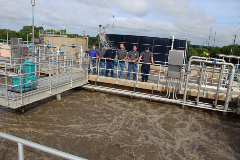Innovative Project Increases Flow Capacity and Reduces Utility Footprint

The Upper Trinity Regional Water District (UTRWD) owns and operates the Riverbend Water Reclamation Plant (WRP) in Aubrey, Texas. The plant was originally constructed with a sequencing batch reactor (SBR) process for activated sludge. This process was ideal for the initial incremental growth in the service area. However, the area saw rapid growth, causing the Riverbend WRP to receive flows and loads nearing its permitted annual average capacity of 2 mgd. Additionally, extreme rain events and resulting inflow and infiltration in the collection system challenged plant operations.
For a conventional activated sludge plant, staff can monitor and adjust the aeration basin operation with dissolved oxygen measurements a few times a day. However, the SBR process with diminishing excess capacity required operations staff to collect multiple samples and run laboratory tests to optimize the fill, aeration, anaerobic, settling, and decant stage times. Operators had to make continuous adjustments based on the results of these tests to provide optimum SBR cycle times to produce high-quality effluent. Although these modifications allowed the treatment process to keep up with flow increases, UTRWD staff recognized the need to make operations easier to manage.
In January of 2016, UTRWD initiated a project to improve operational reliability and increase flow capacity. The goals were to convert the SBR plant to conventional activated sludge with plug flow aeration basins and secondary clarifiers and increase the permitted capacity from 2 to 4 mgd, without constructing additional aeration basins. To meet projected growth, the project also had to be completed in less than three years. To achieve these goals, UTRWD selected an innovative treatment technology: ballasted activated sludge. And, to meet the project’s short timeframe, UTRWD opted for the construction manager at-risk (CMAR) project delivery method.
Though the goals of the project were challenging, the plan was successfully implemented. Construction was substantially complete and the plant was placed back into service by June of 2019. The expanded and improved plant successfully addressed the goals established at the start: (1) improved operations by converting existing SBRs to conventional activated sludge, (2) doubled aeration capacity within the existing SBR basins by implementing a ballasted activated sludge system, and (3) achieved the accelerated project schedule using the CMAR delivery method.
For this innovative project, the Upper Trinity Regional Water District was recognized with a National Environmental Achievement Award in the Operations & Environmental Performance category during NACWA's Winter Conference in February 2020. Congratulations to UTRWD and everyone involved!